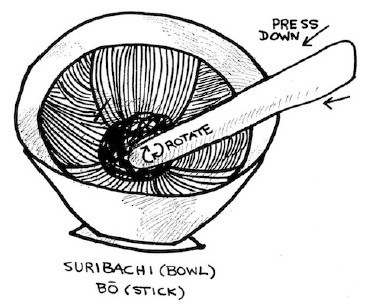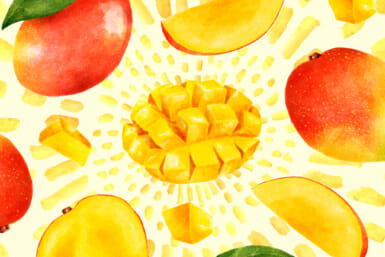There is a very special and wonderful appliance in Japanese cooking, crushing, grinding, blending and mixing. Called a suribachi, it is a type of mortar and pestle.
The bowl (mortar) is serrated and traditionally made of pottery, though the modern versions are often of plastic. The stick (pestle) is always of wood.
Available in several sizes in the housewares section (katei yohin), the prices range from ¥600-1,800 for the suribachi and from ¥180-280 for the bō (stick).
Some suribachi come with plastic or rubber grips on the base to prevent the bowl from slipping while in use. A damp (but well wrung-out) towel or dishcloth layed between counter and suribachi will do quite well, too.
The friendliest arrangement is to have someone else hold the bowl while you grind. Once you get the idea its quite simple to whip up or rather grind up—a tasty dressing or sauce in a few minutes.
Although the suribachi can be used for preparing many kinds of foods, sesame seed dressings are tasty, nourishing, and will provide fine practice in the art of suribachi-ing. The basic procedure is:
- Dry roast the sesame seeds in a pre-heated metal pan over direct, high heat. Rotate and gently shake the pan being careful not to burn the seeds. Well-roasted seeds should be golden in color (a few may “pop” in the roasting process).
- Transfer the dry-roasted seeds, while they are still warm, to the suribachi.
- Hold the bō (stick) with both hands one hand on top, the other down near the base. The top hand’s function is to press down, while the bottom hand rotates the stick clockwise or counter-clockwise (which ever seems easiest) against the serrated sides of the suribachi.
- Grind sesame seeds until they have all been cracked open (a marvelous aroma awaits you). Add any dry ingredients (such as salt or sugar) and grind a bit more. Add any liquid ingredients (shoyu, sake vinegar etc.) and mix all by a few more grinding motions.
Some special notes on suribachi:
1. Never use a rubber spatula to scrape down the sides (the rubber will shred and crumble and taste awful). Scrape down with bō or wooden shamoji (paddle-like spoon).
2. To clean, fill the suribachi with warm sudsy water and let it soak for a while (20-30 minutes). Rinse well, and turn upside down to dry. If you must scrub, then do so WITH the grain, not against.
3. A suribachi is great for Western things too – especially creaming butter or shortening and sugar: softened butter should be “churned” against the serrated sides, adding a hit of sugar at a time.
* * *
INGEN NO GOMA AE (stringbeans in sesame dressing)
ingredients:
- 1 bunch fresh stringbeans (approx. 200 grams)
- 3 tablespoons white sesame seed (shiro goma)
- 2 1/2 tablespoons shoyu
- 2 tablespoons sugar
instructions:
1. Blanch the string-beans in boiling salted water until barely tender (they should still have a “crunch” to them). Drain well and cut them into 1 – 1 1/2 inch lengths. Set aside to cool (don’t plunge into cold water or the final salad will be watery).
2. Dry roast the sesame seeds and crush them while still warm in the suribachi. Add sugar and shoyu as you grind.
3. Just before serving, toss the stringbeans in the sesame dressing. Serve chilled, or at room temperature.
* * *
Celery and Cucumbers, GOMA SUJOYU AE (salad in tart sesame sauce)
ingredients:
- 2 stalks celery
- 2 cucumbers
- 1 1/2 tablespoons white sesame seed (shiro goma)
- 1 1/2 tablespoons vinegar
- 1 1/2 tablespoons shoyu
- 1 teaspoon sugar
- pinch salt
- up to 1 tablespoon water (optional) to thin out
instructions:
1. Wash and pat dry the celery and cucumbers. Cut into matchstick or fine dice.
2. Dry roast the sesame seeds and transfer them to the suribachi while still warm. Grind, adding other ingredients in the process.
3. Toss the celery and cucumbers in the dressing. Serve chilled, or at room temperature.









